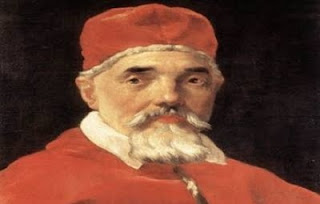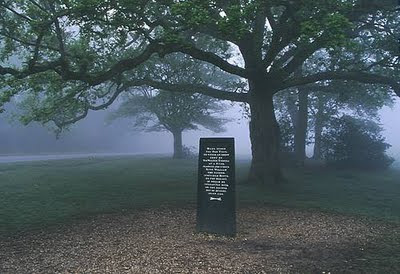 |
| WILLIAM II KING OF ENGLAND |
William the Conqueror, on his deathbed, had split the lands into two parts, he gave England to William Rufus and gave Normandy to his other son Robert Curthose. This proved to be a dilemma for the nobles who had land on both sides of the Channel.
William and his brother Robert were arch rivals which worried the nobles, they could not please both of their lords and ran the risk of offending one or the other. There was only one solution and that was to unite England and Normandy again, under one rule. This led the nobles to revolt against William, in favour of Robert, in the rebellion of 1088, under the leadership of the powerful Bishop Odo of Bayeux, half-brother of William the Conqueror. William won the backing of the English by promising them silver and a better government. In 1091 William invaded Normandy and crushed Robert's army, forcing Robert to cede a portion of his lands. The two brothers eventually put their differences aside and William agreed to help Robert recover lands lost to France. This plan was later squashed, but William continued with his pursuit of France until his death in 1100.
Less than two years after becoming king, William II lost his father's adviser and confidant, the Italian-Norman Lanfranc, Archbishop of Canterbury. After Lanfranc's death, the King delayed appointing a new archbishop for many years, allocating pastoral revenues in the meantime. In 1093 William became seriously ill and in panic nominated another Norman-Italian, Saint Anselm of Canterbury as archbishop. He was considered the greatest clergyman of his time, but this led to a long period of animosity between Church and State. Anselm was a stronger supporter of the Gregorian reforms in the Church than Lanfranc. William and Anselm disagreed on a range of orthodox issues, in the course of which the King declared of Anselm that;
"Yesterday I hated him with great hatred, today I hate him with yet greater hatred and he can be certain that tomorrow and thereafter I shall hate him continually with ever fiercer and more bitter hatred".The English clergy, beholden to the King for their advancements and livings, were unable to support Anselm publicly. In 1095 William called a council at Rockingham to bring Anselm to heal, but the archbishop remained firm. In October 1097 Anselm went into exile, taking his case to the Pope. The diplomatic and flexible Urban II, a new pope, was involved in a major conflict with the Holy Roman Emperor Henry IV, who supported an anti-pope. Reluctant to make another enemy, Urban came to an agreement with William Rufus, whereby William recognised Urban as pope and Urban gave sanction to the Anglo-Norman church's current situation. Anselm remained in exile and William was able to claim the revenues of the archbishop of Canterbury to the end of his reign.
 |
| King Malcolm III of Scotland |
 |
| Carlisle Castle built in 1092 |
 |
| Pope Urban II |
As regent, William campaigned in France from 1097 to 1099. He gained hold of northern Maine, but failed to capture the French controlled part of the Vexin region. At the time of his death, William was planning to invade Aquitaine, in south-western France.
One-night in August, in the year 1100, William had a dream that:-
'he was let blood by a surgeon and that the stream was reaching up to heaven, it clouded the light and intercepted the day.'He suddenly awoke, commanded a light to be brought and forbade his attendants to leave him. After dinner the following day, he went into the forest, attended by a few people. The King was alone, but Walter Tirel had remained with him, while the others who were involved in the chase, were off hunting their kill. The sun was now setting when the King, drawing his bow and letting fly an arrow, had slightly wounded a stag which passed before him. He followed it with his eyes, still running, for a long time, holding up his hand to keep off the sun's rays. At that moment, Walter attempted to shoot another stag, but without realising it, he had pierced the King's chest with an arrow. He had no way of stopping the fatal arrow in mid flight.
The King fell to his knees in silence, he broke off the shaft of the arrow where it had protruded from his body and then fell on the wound which brought on his death quicker. Walter immediately ran up to the King, but he found him making no sense and without speech. He jumped up on his horse and fled quickly, he had just killed the King. There was no one to pursue him. Some people were conspiring to help him flee, others were pitying him. Some began to fortify their dwellings, others to plunder and the rest to look out for a new king.
The local countrymen picked up the King's body, placed it on a cart and took it to the Cathedral at Winchester, with blood dripping from it all the way. William was committed to the ground within the tower, where many of the nobility attended. The following year the tower fell. William died on 2nd of August 1100, aged about forty years. He was a man much to be pitied by the clergy for throwing away the soul they had worked so hard to save.
A stone known as the Rufus Stone marks the spot where he supposedly fell. The inscription on the Rufus Stone reads:
Here stood the oak tree, on which an arrow shot by Sir Walter Tyrrell at a stag, glanced and struck King William the Second, surnamed Rufus, on the breast, of which he instantly died, on the second day of August, anno 1100. King William the Second, surnamed Rufus, being slain, as before related, was laid in a cart, belonging to one Purkis, and drawn from hence, to Winchester, and buried in the Cathedral Church, of that city.
 |
| THE RUFUS STONE |
William was succeeded by his brother, Henry I, William the Conqueror's 4th son.

Quite interesting, he's one King you don't hear much about.
ReplyDelete